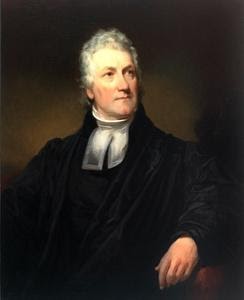|
Dear St. PJ’s friends, To continue sharing some of what I have learned while researching PJ’s history, here are a few bits and pieces of history that focus less on the building and the architecture, and more on the people who made up this congregation over the years, and the cultural context of the neighborhood and beyond. Cultural significance: During the early 19th century, thanks to the Second Great Awakening and the dynamism of their rector, Rev. Dr. Harry Croswell, the parish of Trinity Church in New Haven expanded rapidly. To accommodate growing numbers, they decided to build a “chapel of ease” in a new, outlying residential district, Wooster Square. For 15 years (1830-1845) St. Paul’s was a chapel of Trinity, before breaking away and becoming its own independent parish. A bit about Harry Croswell: He was a New York journalist involved in the famed Supreme Court case People vs. Croswell (his lawyer for the case was Alexander Hamilton!), which was key in protecting the freedom of the press and establishing libel laws. He left politics and journalism to join the church, becoming the rector of Trinity Church, New Haven. During his tenure the Episcopal church grew from one to eight churches in New Haven, of which St. Paul’s was the first after Trinity. He is also famous for being the first to publish the definition of the word “cocktail” during his time as a journalist: Cock-tail, then, is a stimulating liquor, composed of spirits of any kind, sugar, water, and bitters; it is vulgarly called bittered sling, and is supposed to be an excellent electioneering potion, in as much as it renders the heart stout and bold, at the same time that it fuddles the head. It is said also to be of great use to a democratic candidate: because a person having swallowed a glass of it, is ready to swallow anything else. In 1851, gas lighting was installed at St. Paul’s. Around this time, most of the parish income was from pew rentals, since men would pay large sums for their pews, as they were a symbol of status and “gentility.” Wooster Square was made up primarily of wealthy entrepreneurs and ship captains a the time. Around 1879, the population of the church began shifting from wealthy aristocratic families to a city church full of people from all classes and localities. During a time when many churches were moving to “better neighborhoods,” St. Paul’s was proud to stay where they were and adapt to shifting populations in the city. In 1911, Wooster Square became the hub for an influx of Italian immigration, whose legacy lives on through several renowned pizzerias that can still be found on Wooster Street. St. Paul’s once again considered moving, but decided not to leave their beautiful building, and in fact became the last remaining of four Protestant churches in the area. There was some effort put in to attracting the Italians, including having a service in Italian, but it was not very successful because the Italians were “too Catholic.”
During the period of World War I, particularly in 1918, church was in a bit of a decline generally, with energy and money diverted to the war effort. The rector at the time, George Paine, left for the front in 1918, giving his resignation. According to records of a Recognition service in June, 1918, 84 stars were placed on a service flag for parish members who served in the war. Most of these served in the Twenty-Sixth Division, and none of them died. The 1920s brought about several key changes in the church. On January 24, 1924, two women were elected to the Vestry, the first two women to hold the position in the Diocese of Connecticut. Since then, women have always served on St. Paul’s vestry. Then in 1926, a free pew system was put in operation, to “bring the right atmosphere into the Church of Christ.” In 1941, the U.S. entered World War II, and many young people went off to war. The service flag at St. Paul’s included stars for 165 young men and women serving. The Wednesday morning church service became a service dedicated to praying for them. Since gasoline was rationed, church and Sunday School attendance dropped off, as many families could no longer make it to church. During the 1950s, Wooster Square gained national renown for preservation and urban renewal efforts, and the neighborhood was designated a National Historic District in 1971. St. Paul’s rectory and St. Paul’s Church Home for Women were two properties that greatly exhibited the historic architecture of the district. St. PJ's has always been at the forefront of progressive development, electing the first women to the Vestry in the Diocese of Connecticut, and being an early church to integrate racially. This legacy of neighborhood engagement and inclusion is encompassed beautifully in the mural by Julie Dickerson in our basement entitled "Dance with the Saints" (2010), featuring important local figures dancing with saints throughout history. These include a New Haven Ballet dancer, the founder of AA, a capoeira dancer, Martin Luther King, Jr., among others. Hopefully these glimpses of the people and the neighborhood through the years helps connect us to those who came before. Much of this history is summarized, lost, or missing, and we can only imagine what these people were really like, their hopes and dreams and faith, yet we can feel their legacy and presence in our church. That being said, this history I’m compiling is a work in progress, and if anyone has any information or stories they would like to add, particularly in our more recent history, please feel free to email ([email protected]) or call me (847-624-5685)! Stay tuned next week for more information on St. PJ’s history of mission and outreach throughout the years! Peace, Claire
1 Comment
|
AuthorClaire Cody ArchivesCategories |
Directions
|
Weekly Services
|



 RSS Feed
RSS Feed